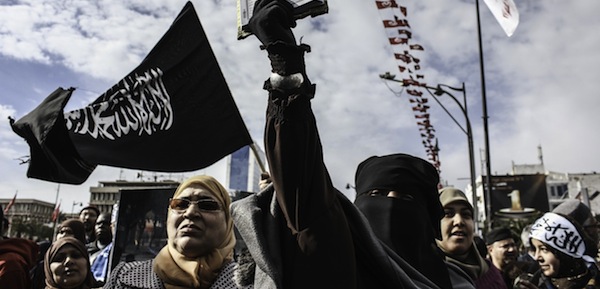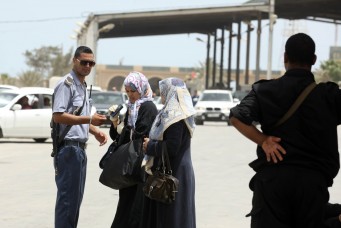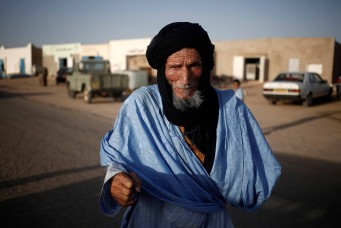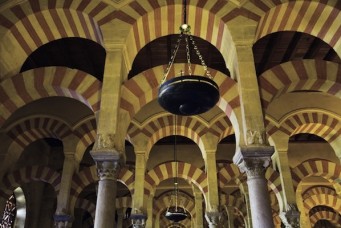Salafism’s March through North Africa
“This is not the Tunisia we know,” the head of a respected Tunisian think tank told me as thousands of Salafists marched through the heart of Tunis’s old Medina, steps from one of its most exclusive restaurants, one that serves premium French wine under the watchful eye of a stern sommelier.

Salafis protest on the second anniversary of the Tunisian revolution, Tunis, Jan. 14, 2013. Chedly Ben Ibrahim/Corgis.
“This is not the Tunisia we know,” the head of a respected Tunisian think tank told me as thousands of Salafists marched through the heart of Tunis’s old Medina, steps from one of its most exclusive restaurants, one that serves premium French wine under the watchful eye of a stern sommelier.
But the city was Tunis, and the protestors were Tunisians. One of the Arab world’s most progressive societies, with one of the most active civil society environments in the entire Arab world, and a notable history of gender equality and secularism, is clearly witnessing the rise of an assertive socio-political force that defines itself exclusively under a strict religious frame of reference. The scale of these marches —and various other forms of assertiveness—and the frequency with which they take place indicate that this trend is far from marginal or dismissible.
In Egypt’s last parliamentary election, Salafist parties won about a quarter of the votes. Amid the polarization that the country is currently witnessing, several Salafist voices and parties are increasingly influential in the political sphere. And the rise of Salafism is also taking place in Morocco, Algeria, Libya, Syria, Sudan, and in other Arab countries.
Most Arab social observers trace this phenomenon to the expansion of Wahhabi thinking over the last thirty-five years; Wahhabism is the conservative Islamic school of thought that Sheikh Mohammed Ibn Abdelwahhab started in the eighteenth century in the Arabian Peninsula. It continues to be the guiding religious ideology of the Saudi regime and its key allies in the country, especially within the religious establishment in the kingdom. The argument goes that the 1970s oil bonanza, the immense wealth that the Saudis accumulated and gradually started to deploy across the Arab (and Islamic) world, and the waves of immigration from poor Arab countries to the Gulf, and chiefly Saudi Arabia, allowed the Wahhabis to extend their influence to the old cultural centres of the Arab world—in Egypt, the eastern Mediterranean, and North Africa. And that this wave of immigration, amidst gradual but structural changes, in the composition of the middle classes of these poor Arab countries, resulted in increased religiosity, severe weakening of the liberal values that spread in the region during the Arab liberal age (roughly in the first half of the twentieth century), and the introduction and slow propagation of values “imported” from the Peninsula: the harsh norms and values of the desert took over the heritage of the relaxed agricultural and trading societies of the rest of the Arab world.
This explanation, through correct, is lacking. A key reason behind the rise of all religious ideologies across the Arab world in the past three decades—whether Salafist, mainstream Islamic, or Christian—has been the failure of Arab liberalism and Arab nationalism, the two schools of thought that had dominated the Arab world from the mid-nineteenth century to the 1970s. The former opened the Arab world to modern Western-style education and social norms; this experiment gave rise to, arguably, the Arab world’s golden cultural age. Its failure, however, was that it tried to create ‘Paris on the Nile’ in Egypt and in the manicured streets of Tunis, Algiers, Beirut, and other Arab urban centers. The states of development of local communities, the severe problems in the educational systems, the different economic circumstances, and crucially centuries of heritage that were at odds with the imported ideas, were ignored by elites who were more comfortable in the salons of Paris, Rome, and Vienna, than in the villages of the Nile Delta or the Tunisian and Levantine interiors.
A wave of bottom up anger, prevailing shocking levels of inequality between the upper crusts of Arab societies and the vast majority of the people—and the ambitions of broad segments of these societies—triggered and empowered Arab nationalism. The secularism of this movement, its role in leading the pan-Arab fight against colonialism, and the immense appeal it had acquired by charismatic leaders such as Habib Bourguiba, Houari Boumediene , and of course Gamal Abdel Nasser, catapulted it to command the imagination of tens of millions of Arabs from the mid-1950s to the 1970s. But, without exception, all the different branches of Arab nationalism—in Egypt, Tunisia, Syria, Algeria, and elsewhere —failed to follow through on the promises they had made.
The “revolutionary” Arab regimes that had espoused Arab nationalism and based their legitimacy on the consent of the people and championing their needs and wants, gradually became tiny elites at the very top of highly unequal societies. Throughout the Arab world, mergers of wealth and power took place. Amidst the bankruptcy of the old ideologies, religion—the last resort—took center stage.
Salafism—the return to “pure Islam,” to the “trusted ways of the pious predecessors” and the “purity of the religion”—found a fertile ground.
Economics also played a role. The largest Salafist groups in the Arab world did not have service infrastructures and business networks similar to the ones that groups such as the Muslim Brotherhood have developed over decades. But they were more prosaic philanthropists. Take the myriad of charity and support groups that have existed for decades within the religious milieus of mosques such as Al-Seyeda Zainab in Cairo or Al-Sayed Al-Badawi in Tanta, among many other examples in North Africa and the eastern Mediterranean. Funded through hundreds of philanthropists and managed through loosely connected organizing committees, these charity networks have provided support to tens of thousands of poor and lower middle class families over decades—from helping with the costs of marrying the daughter, to assisting with the clothing of the children before the school-entry season, to paying for mass-Haj trips. And though the vast majority of these networks were hardly ever politicized (unlike the service infrastructures of mainstream political Islamic groups) they provided ground bases and loyal supporters for when Salafist groups coalesced into parties.
Mainstream political Islamic groups, such as the Muslim Brotherhood, have traditionally focused on politics, notably municipal elections, presence in professional syndicates and student unions, parliaments, etc. —with an objective of Islamising “the state.” In contrast, Salafist groups eschewed politics and focused on charity work. The underlying logic was that missionary and “call to religion” work would create “better Muslims,” and in turn gradually “Islamize the society.” This meant being less competitive, less organized, and less conspicuous and accordingly more popular, especially in traditionally pious and conservative societies such as Egypt, or the Tunisian or Moroccan interior. It also meant that the Salafist groups had not clashed with the secular regimes that had ruled North Africa and the eastern Mediterranean for the past seven or eight decades; and as such avoided the smearing campaigns that groups such as the Egyptian Muslim Brotherhood or the Tunisian Ennahda party had endured.
Interestingly, the current incarnation of Salafism is vastly different from the ones that had flourished in the Arab world previously. In the ninth century, at the height of the Abbasid caliphate, arguably the golden age of the Islamic civilization, various Islamic thinkers revelled in translating Greek philosophy and gradually merged many of its features with the tenets of Islam. The courts of the Abbasid caliphs in Baghdad, and the various Islamic states in Andalucia, witnessed highly progressive (even by today’s standards) discussions on the role of religion in society, the nature of the divine, the religious mandate of scholars, and on borrowing from other traditions. The return to the “salaf” (predecessor), at the time, was for many leading thinkers, analogous to returning to the open interpretation of the Koran and of the meanings and lessons inherent in Islam’s early days, before any institutionalisation had taken place.
Similar thinking emerged towards the end of the nineteenth century. The openness of the Arab world to modernity—initially in Egypt and the eastern Mediterranean, and later to other parts—gave rise to Islamic thinking that sought to return to the “original rationality” of Islam without alien notions that centuries of backwardness and indolence have imposed on it. For many Islamic scholars, it was imperative not to reject modernity as many had done but to situate it within an overall thinking milieu that is reconcilable with religion. Thinkers such as Gamal El-Deen al-Afghani and Mohamed Abdou and others encouraged borrowing and learning from the west, cultural cooperation, and challenged the religious authorities in leading Islamic capitals to acknowledge that the golden days of the Islamic civilization were those when it was confidently open to others.
Today’s Salafism is different. It is extremely entrenched in modernity when it comes to economic thinking and practice yet acutely distrustful of modernity in its social and humanistic facets. The first is a result of quick adaptation to the most successful mass media in today’s digital age as well as to the fact that the majority of the emerging leaders of these groups are alumni of graduate schools and professionals, often boasting successful stints in the corporate world. The second emanates from a deep rejection to almost all the ideologies that had emerged in the Islamic world in the past few centuries, especially in the nineteenth and twentieth centuries after the openness to and borrowing from the West. This view is entrenched in a belief that the Arab (and Islamic) world has deviated from the correct path laid by Prophet Mohammed and his companions, as well as a conviction that the ‘borrowing from the West’ is in reality humiliating servitude.
Rejectionism works when vast segments of young people are angry at their socioeconomic conditions and seek an ultimate, unquestionable truth to them. But this strategy cannot survive in the medium term. The more this ideology rises in local socio-politics, the more it is expected to contribute practical solutions to the society’s problems (from education, to transportation, to water and electricity, to monetary and fiscal programmes, to job creation, to the myriad of complicated challenges that any public policy strategist in the Arab world faces).
The largest Salafist parties in the Arab world are already evolving from religious movements—ones that connect with the faith of the people—to political forces, with practical solution to everyday problems.
Here lies the two variables that would determine the future of Arab Salafism. The first would be whether the Salafist parties are capable of building serious and sophisticated in-house policy making capacities that could make them credible policy makers. It took the Muslim Brotherhood in Egypt over half a century to shepherd that transition, as the Brotherhood had established organizational structures, deep financial resources, and the ability to draw on various experiences in different places in the world. None of the large Salafist parties (or movements) in the Arab world today has any of these advantages. But, unlike the period in which the Muslim Brotherhood made that transition, the Salafist forces today are at the center of an immense social and political transformation of their societies. The gravity of the moment, and the attractions of the opportunity, could make them make a historical leap. If they succeed in building these policy-making capacities, they could quickly emerge as very powerful political players. If they fail, they will end up marginal parties that augment governments, but never exercise real power.
The second variable would be their ability to reconcile their purely Islamic frame of reference with their local, national identities. This is a huge challenge. In countries such as Egypt, Tunisia, Syria, Morocco, and others, national identities are strong, proud, and thoroughly entrenched in the social psyche. They appear weakened when their societies are in the midst of difficult social, economic, and political transitions, but they are far from diluted. If the Salafists fail to connect with Egyptian-ness, Tunisianity, etc., they will severely antagonize broad segments of their societies. And in this case, almost certainly they will end up losers in this major wave of transformation.
Modern Salafism was a lucky ideology. It found a fertile ground in Saudi Arabia, which, for the past four decades, had emerged as the most influential Arab country. But following the current transformations that the wave of uprisings has given rise to, the center of gravity in Arab socio-politics will return to the eastern Mediterranean and North Africa. And Salafism will lose the momentum that Saudi backing (and petrodollars) have given it.
Salafism’s traditional approach of trying to “purify” their societies from what they consider impurities that have been imposed on them will not resonate with the almost 200 million Arabs under thirty-five years of age, whose priorities are largely economic, not ideological, and who are mostly ill-disposed to indoctrination. Salafism’s ability to evolve in the culturally richest parts of the Arab world—become capable political forces as opposed to missionaries, and locally integrated players as opposed to harbingers of purely Islamic identities—will be its fundamental challenge.
Tarek Osman is the author of the international bestseller Egypt on the Brink. He has published articles on Egypt and the Middle East in leading international newspapers.





